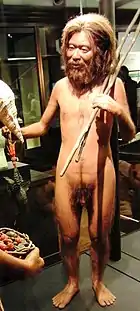Proto-Mongoloid
In archaeogenetics "Proto-Mongoloid" refers to a suggested group which is considered to be part of the "Mongoloid" group. Notable examples of fossils exhibiting proto-Mongoloid phenotypes are found in Late Pleistocene (Upper Paleolithic) fossils, notably the Minatogawa skeletons and the Liujiang crania.[1]

The Jōmon people of Japan, Southeast Asians, Pacific islanders, and Native Americans retain some plesiomorphic traits derived from Proto-Mongoloids. Modern East Asians represent the most direct descent.
Morphological characteristics
While the Jōmon are relatively short, and have finely chiseled features, most times double eyelids, much body hair and often wavy hair which resemble pseudo-Caucasoid traits, the Proto-Mongoloids are often described as "straight-haired type, medium in complexion, jaw protrusion, nose-breadth, and inclining probably to round-headedness".[2]
Professor of anthropology, Akazawa Takeru (赤沢威) at the International Research Center for Japanese Studies, Kyoto, said that there are Neo-Mongoloids and Paleo-Mongoloids. Akazawa said Neo-Mongoloids have "extreme Mongoloid, cold-adapted features" and they include the Chinese, Buryats, Eskimo and Chukchi. In contrast, Akazawa said Paleo-Mongoloids are less cold-adapted. He said Burmese, Filipinos, Polynesians, Jōmon and the indigenous peoples of the Americas were Paleo-Mongoloid.[3]
While it is suggested that the proto-Mongoloid group belonged largely to the Sundadont dental structure, it is more likely that it they belonged to their own Mongoloid dental structure.[4] C.G Turner II shows with his analysis of 2016 that Sundadonty is the proto-Mongolid dental morphology and is not connected to the "Australoid dental morphology". He also shows that Sinodonty is predominant in Native Americans.[5] Analysis on the Sinodonty and Sundadonty of New world groups by G.R. Sott et al. (2016) shows the distinction between East Asians and Southeast Asians is not very big and that the Mongoloid dental structure can be seen as one "super-dental structure".[6]
Genetics
Recent genetic researches suggest that the closest relatives of Proto-Mongoloids are Neo-Mongoloids, and their ancestors split thousands of years ago. An admixture between different groups in very early times, which formed the so-called "Proto-Mongoloids" remains also a possibility.[7]
"Neo-Mongoloid" (modern Mongoloid) migration to Japan is associated with the Yayoi people (8th-3rd centuries BC). The Yayoi interbreeding with the indigenous populations formed the stock of the modern Japanese people.[8] Modern Japanese have about 10% Jōmon ancestry.[9]
However, the origin of the Jōmon people is still disputed as most scientists suggest that the Jōmon were not a single homogeneous people but an admixture of (at least) two distinct populations.[10][11]
See also
References
- Matt Cartmill, Fred H. Smith, The Human Lineage, John Wiley & Sons (2009), p. 449.
- Parsons, Elsie Clews (2013-02-20). North American Indian Life: Customs and Traditions of 23 Tribes. Courier Corporation. ISBN 9780486148137.
- Takeru Akazawa and Emóke J.E. Sathmåry. Prehistoric Mongoloid dispersals. New York, Oxford University Press, 1996.
- Anthropological Science: Journal of the Anthropological Society of Nippon, Volume 101
- Pilloud, Marin; Heim, Kelly; Schmitz, Kirk; Paul, Kathleen (2018). "Sinodonty, Sundadonty, and the Beringian Standstill model: Issues of timing and migrations into the New World". Quaternary International. 466: 233–246. Bibcode:2018QuInt.466..233S. doi:10.1016/j.quaint.2016.04.027.
- Paul, Kathleen; Schmitz, Kirk; Heim, Kelly; Pilloud, Marin (2018). "Sinodonty, Sundadonty, and the Beringian Standstill model: Issues of timing and migrations into the New World". Quaternary International. 466: 233–246. Bibcode:2018QuInt.466..233S. doi:10.1016/j.quaint.2016.04.027.
- Kanzawa-Kiriyama, Hideaki; Kryukov, Kirill; Jinam, Timothy A; Hosomichi, Kazuyoshi; Saso, Aiko; Suwa, Gen; Ueda, Shintaroh; Yoneda, Minoru; Tajima, Atsushi (February 2017). "A partial nuclear genome of the Jomons who lived 3000 years ago in Fukushima, Japan". Journal of Human Genetics. 62 (2): 213–221. doi:10.1038/jhg.2016.110. ISSN 1434-5161. PMC 5285490. PMID 27581845.
- Studies on the affinities of Sakhalin Ainu based on dental characters: The basic populations in East Asia, III T Hanihara - Journal of the anthropological society of Nippon, 1990
- "'Jomon woman' helps solve Japan's genetic mystery | NHK WORLD-JAPAN News". NHK WORLD. Retrieved 2019-07-20.
- Professor, Miura Sukeyuki-; University, Rissho; Director, Shinoda Kenichi-; Anthropology, Department of; Nature, Japanese National Museum of; Science (2016-06-03). "The Origins of Japanese Culture Uncovered Using DNA ―What happens when we cut into the world of the Kojiki myths using the latest science". Discuss Japan-Japan Foreign Policy Forum. Retrieved 2019-01-21.
- "蝦夷とアテルイ". masakawai.suppa.jp. Retrieved 2019-03-26.
